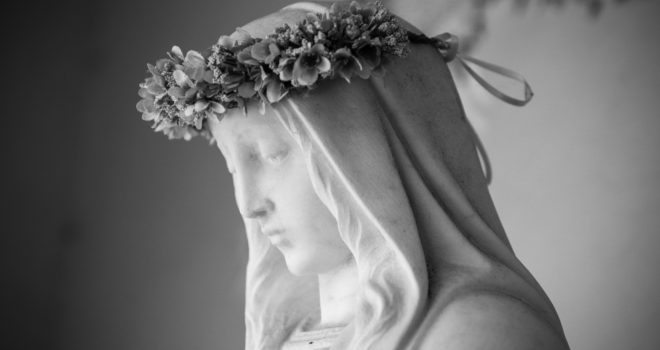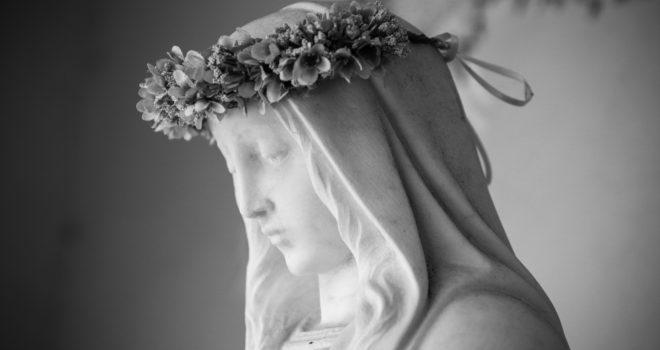The Immaculate Conception – our Catholic dogma that Mary was preserved from contracting original sin at her conception – is something that seems to set us apart from our Protestant brothers and sisters. The truth, however, is that it expresses a point of faith particularly dear to the Protestant Reformers: We are brought into relationship with God, or justified, not through any works or merit on our part but solely by the grace of God. Mary was saved from sin as a result of Christ’s redemptive work. . .reaching back through time to preserve her from sin and unite her soul to God from the first instance of her existence. And we Catholics have strong biblical precedents that we can share with separated brothers and sisters to help illuminate this Marian dogma.
Let’s begin with a principle that is embraced by all Christians: The realities of the New Testament far surpass their “shadows,” their prefigurements, in the Old (Heb 10:1; 8:5-6; 12:22-24). Saint Paul, for example, referred to Adam – God’s created son, the physical head of our race – as “a type of the one who was to come,” Jesus (Rom 5:14). So too, Christ is the head of a new, redeemed humanity; but in a glorious contrast to Adam: Adam was God’s son by adoption, but Christ by divine filiation. The first man was of earth, the second of heaven (1 Cor 15:45-49). “As one man’s trespass led to condemnation for all men, so one man’s act of righteousness leads to acquittal and life for all men” (Rom 5:18). The New does not just equal, but vastly surpasses the Old; and what is true of Adam and Jesus is also true of Eve and Mary.
When we meet Eve in Scripture, she comes to us fresh from God’s creative hand. She was a daughter bearing His image and likeness (Gen 1:26; 5:3), living in intimate friendship with God. When her sin, however, placed her under the dominion of death and the devil (Gen 3:3; Wis 2:24; Eph 2:1-3; 1 Jn 5:19), God immediately spoke of another Woman – one at “enmity” with the devil – and her Seed, who would crush the serpent’s head (Gen 3:15). In the Gospel of John we find Jesus referring to Mary as the prophesied Woman (2:3-4; 19:26-27), with this point reinforced in John’s Book of Revelation (12:1-5, 17). If the first woman, the “mother of all the living” (Gen 3:20), was created in God’s friendship; the biblical principle we have observed up until this point, would say that the same was true of Mary. When we turn to the annunciation narrative we find the Angel Gabriel addressing Mary exactly as we would expect – “Hail Kecharitōmenē”(Lk 1:28) – meaning one who has been, and is now, absolutely filled with the grace, the supernatural life, of God.
But how could Mary experience such freedom from Original Sin and union with God prior to Christ’s incarnation and redemptive sacrifice? It was because her Son is the Lamb slain from the foundation of the world (Rv 13:8). Jesus is a divine Person, Who offered himself to the Father “through the eternal Spirit” (Heb 9:14). His redemptive sacrifice reached forward in time to embrace us; but it also reached backward, meriting God’s mercy toward Abraham and his descendants (Heb 10:3-4; 9:24-26; 11:1-2, 17-19, 39-40). Christ’s merits – and they alone – redeem man from the curse of the Fall. There is no supernatural life, no union with God, apart from Him, whether we are talking about the saints of the Old Covenant or the New. We can do nothing to merit this gift of divine adoption, “For it is by grace you have been saved, through faith—and this is not from yourselves, it is the gift of God— not by works, so that no one can boast” (Eph 2:8-9). And at times, God does not even require our faith to appropriate this gift of grace – He is free to distribute His gifts however He wishes (Mt 20:15)!
We see this in the Old Testament and the New. God’s grace, given in view of the merits of Christ, cleansed the prophet Jeremiah of original sin and “consecrated” him a prophet in utero (Jer 1:5). It caused St. John the Baptist to be “filled with the Holy Spirit, even from his mother’s womb” (Lk 1:15). God extended this grace to Jeremiah and John to mold them for the divine work that lay ahead. He did the same for Mary when He called her to the most sublime work, the most intimate union possible between God and a creature – her divine motherhood. Jesus’ sacrifice reached back to not just cleanse Mary of original sin as in the case of Jeremiah and John, but to preserve her from even contracting that damage to our nature that inclines us toward selfishness and sin. She was saved by grace – as are we – but in the most radical way possible; and that grace consecrated her as the New Eve, the new mother of all the living!
After centuries of pondering God’s Revelation the Church came to the point where it could clearly enunciate the truth of Mary’s “Immaculate Conception” to itself and the world. It was not adding something new to the deposit of Faith (Jude 3) from the outside but clearly articulating a truth implicit since the beginning. On December 8, 1854, Pope Pius IX invoked his authority as the Successor of Peter to teach infallibly:
We declare, pronounce, and define that the doctrine which holds that the most Blessed Virgin Mary, in the first instance of her conception, by a singular grace and privilege granted by Almighty God, in view of the merits of Jesus Christ, the Savior of the human race, was preserved free from all stain of original sin, is a doctrine revealed by God and therefore to be believed firmly and constantly by all the faithful (Ineffabilis Deus).
When the Church calls us each year to celebrate what God did for Mary, we recognize and praise what He has done for us too: “Blessed be the God and Father of our Lord Jesus Christ, who has blessed us in Christ with every spiritual blessing in the heavenly places, even as he chose us in him before the foundation of the world, that we should be holy and blameless before him. He destined us in love to be his sons through Jesus Christ, according to the purpose of his will, to the praise of his glorious grace which he freely bestowed on us in the Beloved [Christ]” (Eph 1:3–7).
✠
Editor’s note: this article is adapted from Shane Kapler’s The Biblical Roots of Marian Consecration: Devotion to the Immaculate Heart in Light of Scripture (TAN Books, 2022).
Photo by Marites Allen on Unsplash












